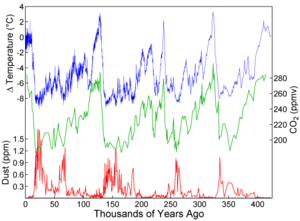
- Image via Wikipedia
Highs and lows
You might think that measuring the levels of greenhouse gases in the atmosphere would be a priority. If you did think that, though, you would be wrong.
IN NEGOTIATIONS on nuclear weapons the preferred stance is “Trust but verify”. In negotiations on climate change there seems little opportunity for either. Trust, as anyone who attended last year’s summit in Copenhagen can attest, is in the shortest of supplies. So, too, is verification.
Barack Obama was asked when he was in Copenhagen whether a provision by which countries could peek into each others’ assessment processes was strong enough to be sure there was no cheating. He answered reassuringly that “we can actually monitor a lot of what takes place through satellite imagery”. That statement conjured up thoughts of the sort of cold-war satellite system that America used to identify and count Russian missiles. But the president was being a bit previous; at the moment, no such system exists, because America’s Orbiting Carbon Observatory (OCO), a satellite that would have fulfilled the role, was lost on launch this time last year. The purpose of OCO was to work out the fate of carbon dioxide that is emitted by industrial processes but does not then stay in the atmosphere—about 60% of the total.
America is planning to build a new OCO. In the meantime, however, a small group of scientists labours away on Earth, doing its best to monitor emissions at ground level. At the end of February a number of these researchers met at the Royal Society in London, to discuss what they were up to.
Measuring gas levels day in, day out can look a little humdrum to outsiders, including those who hold the purse strings. They tend to prefer scientists to experiment and test hypotheses, not just tally things. But that attitude galls the greenhouse-gas measurers, and not only because it denies them money. It also ignores the fact that careful measurement is a way of discovering new things, not just of checking the status quo. Monitoring is not just a necessary handmaiden of science—it is the real thing.
De bas en haut
Governments are required by treaty to inform the world about their greenhouse-gas emissions. To do this, they take a bottom-up approach, using data about how much of the relevant gases all sorts of activities, from steelmaking to dairy farming, are expected to produce and how much of each of those activities is going on. The researchers at the meeting work top down, looking directly at what is in the atmosphere, and how quickly it accumulates.
Ray Weiss of the Scripps Institution of Oceanography in La Jolla, California, has been studying the difference between these approaches. In most cases, he has found that the top-down estimates are appreciably higher. In some, such as that of sulphur hexafluoride, a powerful greenhouse gas that is used as an insulator in high-voltage electronics, the trends as well as the values are different: bottom-up accounts say emissions are falling; top-down analysis says they are going up.
Andreas Stohl of the Norwegian Institute for Air Research and his colleagues have been looking at weather patterns to discover where some of these gases are emitted. The level of a gas seen at a particular monitoring station depends on where it came from and which way the wind was blowing, so if you have a number of stations and some data on how their readings change with wind directions, you can have a good guess at the source.
Among Dr Stohl’s conclusions is the positive one that China now seems to be emitting less HFC-23, a powerful greenhouse gas produced by the refrigeration industry, than it did in 2005. This suggests that the large amounts of money invested through carbon markets in reducing such emissions may be having an effect. More detailed studies might show precisely which industrial regions the gases are coming from, and thus reveal what is going on with specific HFC-23-mitigation projects.
For gases that are sometimes or always produced biologically, such as carbon dioxide and methane, a less geographic way of assigning sources is possible. Living things treat carbon atoms of different weights slightly differently, and these differences show up in the weights of the gases they churn out. So it is possible to distinguish, for example, between methane that has been stored in permafrost and methane that is made by rotting vegetation.
Related articles by Zemanta
- IMF proposes global climate change fund (guardian.co.uk)
- Concerns mount over vague Japanese climate bill (businessgreen.com)
- Black Carbon: A Visible but Overlooked Factor in Warming (time.com)
- Green Blog: The Puzzle of Rising Methane (green.blogs.nytimes.com)








